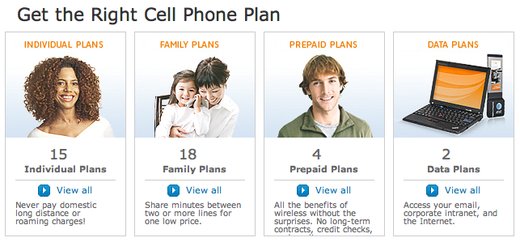
There are nearly 40 different wireless plans offered by AT&T. Talk about a paradox of choice.
You’re reading Signal v. Noise, a publication about the web by Basecamp since 1999. Happy !

There are nearly 40 different wireless plans offered by AT&T. Talk about a paradox of choice.
Sean Eby
on 11 Jan 11More choice is indeed the paradox of choice. Then again, all of those plans also truly do price discriminate which, above all else, is designed to enable AT&T to profit more efficiently. Is that a good decision to offer those or a poor one? I think it’s a good decision, and does let people with different capacity needs for wireless phone, texting, or data, find a plan for which they’re only paying for what they need, give or take some margin here or there, versus having, say 2 or 3 options for every customer.
JD
on 11 Jan 11I am surprised that there isn’t a Good, Better, Best option for cell phone pricing. Why can’t this be simpler? I know I’m picking on AT&T here, but all the wireless companies have these confusing plans.
Neil
on 11 Jan 11Unless I’m wrong (I can’t find the page you’re referring to), this actually 105 plans, since you can (presumably) bundle either data plan together with any of the individual and family plans. It’s possible that bundled data is included in their count, I suppose, but I wouldn’t be surprised if it is just that complicated.
Bdog
on 11 Jan 11There is a really amazing article on how companies try to confuse consumers as a strategy at theFarnam Street Blog.
Stephen Jenkins
on 11 Jan 11I don’t think “Good, Better, Best” works here, there are a lot variables at play, and simplifying the model to three plans would only raise prices across the board.
For example, I live and die by my iPhone, but I barely need any minutes, as all my colleagues use them as well and we can talk for free. That would make me a low minutes, high data kind of guy. The salesperson next door might be on the phone all day, but couldn’t less about email on the go, he would be a high minutes, low data guy.
If anything, a pay per use model would be best, but that won’t happen, so I would like even MORE choices. I would take a 350 minute plan instead of a 450 minute plan, and it would save me $60 a year.
Mike B
on 11 Jan 11Here’s a hint: they’re all terrible. They won’t ever tell you what the real costs are and see you as nothing more than a credit card to exploit and extract as much cash as possible from. The costs have no relationship to their real cost (eg charging $.15-.25 per text message if you don’t have an sms ‘package’ when it costs the providers next to nothing). I’m surprised you were even able to look at plans without having to go through a bunch of phone sales.
qwerty
on 11 Jan 11A paradox is a contradiction in itself. How does more choice lead to a contradiction? Or are you referring to option paralysis?
Timothy
on 11 Jan 11I’m convinced this is why pre-paid phone options are a so much more popular choice in most countries: it’s so much easier to figure out what you’re going to pay per minute and you’re done. When you’re getting low, you put in more money. If you go on vacation for two weeks, you’re not paying for something you’re not using. On top of that, the phones are not locked like they are in the U.S., so you can buy a new SIM card on the road.
In the end, average users are going to pay far less this way (and feel more in control), but in the U.S. system these casual users are subsidizing those who never stop talking, texting, and e-mailing. In that system, the more the general public is confused, the better. I don’t think it’s just the economy that’s driving more Americans into the hands of Boost and the like.
Mike B
on 11 Jan 11FWIW, I use a prepaid phone after receiving a number of absolutely insane bills despite having a plan. The way I see it, I’m setting an upper limit on how much I can get screwed over with prepaid – they can only charge me what is on the account. I don’t have a smartphone yet because there still is no high data / low talk option. I can wait.
TJ
on 11 Jan 11AT&T has never cared about their customers.
Tim
on 12 Jan 11Just finishing up the book “The Innovation Secrets of Steve Jobs” [Gallo].
What I get from this is: UX, Focus. Focus is applicable here. Do a few things, do ‘em well. I know it’s obvious, but some people need to have it re-iterated. Unfortunately, some companies rule by committee, not by commonsense/dictate from one accountable person.
The late nineties return of Steve Jobs and the MacWorld preso where he divided the product range into 4: consumer desktop, consumer portable, pro desktop, pro portable, was telling.
Maybe AT&T could learn something from this.
Over here in Australia, it’s pretty simple. Calls, data. Pick what you want.
So I just pick a $1500 calls/month cap, then add 3G of data [Telstra, $99/month].
Ape-Inago
on 17 Jan 11Choice is only a problem if they don’t make it easy to choose.
I’d say that they do a good job with explaining it via single vs family choices. The issue I see is that Prepaid and Data aren’t really related to the other two choices.
This discussion is closed.